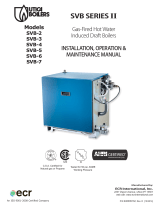
6
DIAGNOSTIC ERROR CODES AND TROUBLESHOOTING PROCEDURES FOR HONEYWELL INTEGRATED
CONTROLS (INDUCED DRAFT MODEL SERIES)
Error
Code
Definition of Code Cause of Problem and Actions Taken to Correct
4
Low Flame Sense
Current
Determine flame sense current in the Service Mode with the water heater
operating. If less than 1.0 microamps, check pilot flame sense rod and wire.
Clean flame sense rod with emery cloth. If problem is not solved, replace pilot.
2
Pressure Switch Failed to
Open (Stuck Closed)
The pressure switch contacts did not return back to the normally open position at
the end of the last heating cycle. The control checks to make sure the pressure
switch is in the normally open position before allowing the blower to start the
ignition sequence. Check to make sure the pressure switch tubing is not blocked.
If the pressure switch tubing is clear, replace the pressure switch.
29
Pressure Switch Failed to
Close
The pressure switch contacts did not close after the blower was energized.
Check to make sure the blower is energized at the beginning of the heating cycle.
If the blower did not start, check to make sure there is power to the motor.
Replace blower or control board if defective. Check to make sure the venting
system is not blocked. Make sure the vent length does not exceed the specified
limits. Make sure the vent terminal is not blocked. Check to make sure the
pressure switch tubing is clear. Replace the pressure switch if the venting system
has checked out O.K. Control will reset once problem is corrected.
6
Flame Sensed Out of
Normal Sequence
(Before Opening Gas
Valve or After Closing
Gas Valve)
Check to make sure gas valve has closed. No voltage should be present at the
gas valve before or after ignition cycle. Make sure wire positions on the wire
harness are correct. If gas valve is stuck open, replace.
23
Flame Detected Before
Ignition
Check to make sure gas valve has closed. No voltage should be present at the
gas valve before the ignition cycle. Make sure wire positions on the wire harness
are correct. If gas valve is stuck open, replace.
24
Flame Detected After
Heating Cycle Completes
Check to make sure gas valve has closed. No voltage should be present at the
gas valve before the ignition cycle. Make sure wire positions on the wire harness
are correct. If gas valve is stuck open, replace.
31
Upper Sensor Readings
Faulty
Resistance of upper sensor out of operating range. Check continuity of wire
harness to upper sensor, and if O.K., replace upper sensor.
32
Lower Sensor Readings
Faulty
Resistance of lower sensor out of operating range. Check continuity of wire
harness to lower sensor, and if O.K., replace lower sensor.
57
Flame Rod Shorted to
Ground
Pilot flame sensor rod is shorted to ground. Check to see if flame sensor wire
has bare spots touching metal parts of if flame sensor rod is touching the pilot
shield or other metal parts. Replace pilot if flame sense wire is damaged or flame
rod is bent. Make sure pilot shield is not touching the pilot flame sensor.
58
AC Line Frequency Error
– Signal Too Noisy or
Frequency Incorrect
Check line voltage frequency to the water heater. Determine if there are wide
fluctuations. Call an electrician if the problem persists. The water heater should
be on a separate line.
59
Line Voltage Too Low or
High
Check line voltage to the water heater. Determine cause of low or high voltage.
Call an electrician or your utility. The water heater should be on a separate line.
61
DC Output Voltage
Unstable
Check line voltage to the water heater for erratic readings. Also check wiring to
make sure there are no shorts. If power supply and wiring are O.K., replace
control board.
62
Maximum Number of
Retries Detected
Pilot is either not lighting or not staying lit during ignition cycle. Check inlet gas
pressure for minimum pressure on rating label. Is pilot electrode sparking?
Check gas valve wire harness for broken wires or shorts. If 24 volts is present
between PV and PV/MV terminals at the gas valve, replace gas valve. Check for
voltage output to the yellow and red gas valve wires on the control board pins. If
during the ignition trial period, there is no voltage present at the control board pin
terminal for the red and yellow wires leading to the gas valve, then replace the
control board. Replace pilot if wires are damaged or electrode is damaged.










